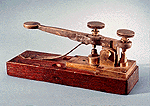|
Internet Enables Fast Communication
Not too many years ago, man relied on cave paintings and smoke signals to reach out to others. With each new advent in information technology, man has found new ways to communicate with existing and potential new customers. Today companies have a variety of technologies to choose from. During the last two centuries, improvements in printing and distribution technologies have enabled printed newspapers and magazines to continue provide information to customers. The railroads and evolving transportation technologies sped up the sorting and distributing of mail throughout the country, and enabled companies to provide printed handbills, flyers and catalogs to customers.
Radio and television also facilitated new ways to disseminate information about products and services. World Wide Web emerges as a place to find information: During the late 1960's, the United States Department of Defense's Advanced Research Projects Agency (ARPA) initiated ARPANet as an interconnected network of university and military computers which could maintain their ability to communicate if a major war were to take place. In 1981 ARPANet was split between a military network and ARPANet, there were just over 200 computers connected at the time. During the mid 1980's ARPANet was absorbed by NSFNET, a similar network developed by the National Science Foundation. Together they became known as the Internet. The World Wide Web, using a system of interlinked hypertext files, was developed in 1989 by Tim Berners-Lee, a British computer scientist. It became part of the Internet in 1991 and is now the primary platform of the Internet. The feature that distinguishes the Web from other Internet applications is its ability to display graphics in addition to text Mosaic was the first popular Web browser, initially released by National Center for Supercomputer Applications (NCSA) in 1993. It greatly helped spread use and knowledge of the web across the world. Today's most popular browsers include Microsoft Internet Explorer, Mozilla Firefox and Netscape. During the last decade the expanding use of personal computers and the growth of World Wide Web have provided evolving ways to more efficiently and quickly communicate with customers, strategic business partners and vendors. Businesses have increasingly used the Internet and electronic data communication to advertise and promote their products and services, to publish their catalogs, to communicate using email and mailing lists, to research markets and materials, and purchase supplies more quickly and efficiently than ever before. It is now estimated that over 70 million people use the World Wide Web each day as a source for information and entertainment. Today a company can provide nearly instant up to date information about products and services to potential customers through company web sites. Customers can search for and locate desired products and services within minutes. The internet also makes two-way communication between businesses and customers easier. The Internet can also allow customers to easily communicate directly with companies to request additional information. Customers can place orders directly at a businesses web site. Customers can sign up for a mailing list to learn about products they are interested in. When new products are announced, email over the internet can reach customers quickly and efficiently. Providing Web Site Solutions: Digital Network Express designs, implements and maintains web sites to help companies and customers connect using the Internet. Samples of our work can be viewed at:
|

 The
development of the telegraph made it possible to use electricity to communicate information from
one part of the country with people in other parts of the country faster during the 1840's. The
invention of the telephone in 1876 allowed electrical communication to become faster and gradually
more accessible to a wider range of businesses and customers.
The
development of the telegraph made it possible to use electricity to communicate information from
one part of the country with people in other parts of the country faster during the 1840's. The
invention of the telephone in 1876 allowed electrical communication to become faster and gradually
more accessible to a wider range of businesses and customers.

